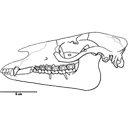Print ISSN: 0031-0247
Online ISSN: 2274-0333
Frequency: biannual
Werneburg et al. New Permian Caseid from France
Field trip guides/EAVP Annual Conference/2023
Embrithopod from Croatia
Hypoplasia: CT-scan or naked eye?
Book of Abstracts/EAVP Annual Conference/2023
Eocene (57) , Quercy phosphorites (37) , Systematics (32) , Rodents (29) , Mammalia (26)
Palaeovertebrata Vol. 37, Fasc. 1-3:October 2012

|
Révision systématique des Anchilophini (Palaeotheriidae, Perissodactyla, Mammalia).Jean-Albert RemyKeywords: Anchilophus; Eocene; new genus; new species; Palaeotheriidae; Paranchilophus; Perissodactyla; Systematicsdoi: 10.18563/pv.37.1-3.1-165 Abstract The knowledge of the Anchilophini has been lately renewed by the discovery of a rather large amount of new material still largely unpublished. This new material offers the opportunity of a systematic revision of this tribe gathering those of European Eocene Equoidea which bear no mesostyle on upper check teeth and display a heavy trend to the molarization of premolars. Article infos |
|